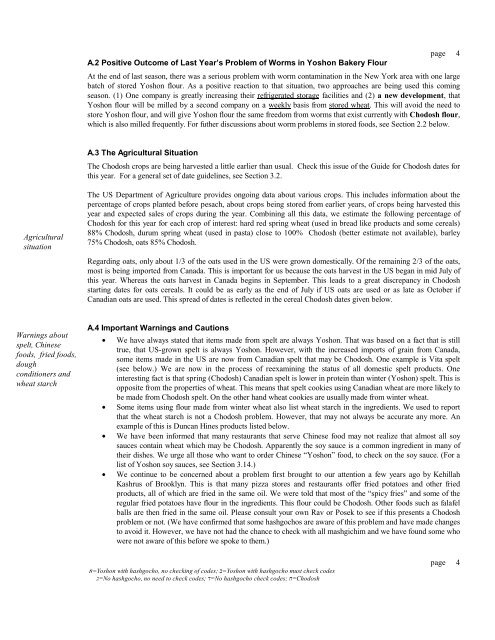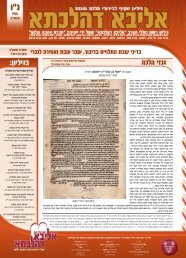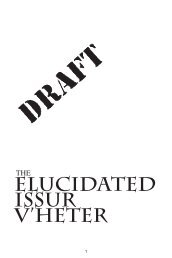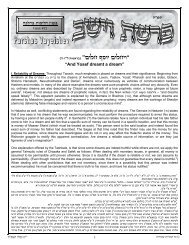Create successful ePaper yourself
Turn your PDF publications into a flip-book with our unique Google optimized e-Paper software.
A.2 Positive Outcome of Last Year’s Problem of Worms in Yoshon Bakery FlourAt the end of last season, there was a serious problem with worm contamination in the New York area with one largebatch of s<strong>to</strong>red Yoshon flour. As a positive reaction <strong>to</strong> that situation, two approaches are being used this comingseason. (1) One company is greatly increasing their refrigerated s<strong>to</strong>rage facilities and (2) a new development, thatYoshon flour will be milled by a second company on a weekly basis from s<strong>to</strong>red wheat. This will avoid the need <strong>to</strong>s<strong>to</strong>re Yoshon flour, and will give Yoshon flour the same freedom from worms that exist currently with Chodosh flour,which is also milled frequently. For futher discussions about worm problems in s<strong>to</strong>red foods, see Section 2.2 below.page4A.3 The Agricultural SituationThe Chodosh crops are being harvested a little earlier than usual. Check this issue of the Guide for Chodosh dates forthis year. For a general set of date <strong>guide</strong>lines, see Section 3.2.AgriculturalsituationThe US Department of Agriculture provides ongoing data about various crops. This includes information about thepercentage of crops planted before pesach, about crops being s<strong>to</strong>red from earlier years, of crops being harvested thisyear and expected sales of crops during the year. Combining all this data, we estimate the following percentage ofChodosh for this year for each crop of interest: hard red spring wheat (used in bread like products and some cereals)88% Chodosh, durum spring wheat (used in pasta) close <strong>to</strong> 100% Chodosh (better estimate not available), barley75% Chodosh, oats 85% Chodosh.Regarding oats, only about 1/3 of the oats used in the US were grown domestically. Of the remaining 2/3 of the oats,most is being imported from Canada. This is important for us because the oats harvest in the US began in mid July ofthis year. Whereas the oats harvest in Canada begins in September. This leads <strong>to</strong> a great discrepancy in Chodoshstarting dates for oats cereals. It could be as early as the end of July if US oats are used or as late as Oc<strong>to</strong>ber ifCanadian oats are used. This spread of dates is reflected in the cereal Chodosh dates given below.Warnings aboutspelt, Chinesefoods, fried foods,doughconditioners andwheat starchA.4 Important Warnings and Cautions• We have always stated that items made from spelt are always Yoshon. That was based on a fact that is stilltrue, that US-grown spelt is always Yoshon. However, with the increased imports of grain from Canada,some items made in the US are now from Canadian spelt that may be Chodosh. One example is Vita spelt(see below.) We are now in the process of reexamining the status of all domestic spelt products. Oneinteresting fact is that spring (Chodosh) Canadian spelt is lower in protein than winter (Yoshon) spelt. This isopposite from the properties of wheat. This means that spelt cookies using Canadian wheat are more likely <strong>to</strong>be made from Chodosh spelt. On the other hand wheat cookies are usually made from winter wheat.• Some items using flour made from winter wheat also list wheat starch in the ingredients. We used <strong>to</strong> reportthat the wheat starch is not a Chodosh problem. However, that may not always be accurate any more. Anexample of this is Duncan Hines products listed below.• We have been informed that many restaurants that serve Chinese food may not realize that almost all soysauces contain wheat which may be Chodosh. Apparently the soy sauce is a common ingredient in many oftheir dishes. We urge all those who want <strong>to</strong> order Chinese “Yoshon” food, <strong>to</strong> check on the soy sauce. (For alist of Yoshon soy sauces, see Section 3.14.)• We continue <strong>to</strong> be concerned about a problem first brought <strong>to</strong> our attention a few years ago by KehillahKashrus of Brooklyn. This is that many pizza s<strong>to</strong>res and restaurants offer fried pota<strong>to</strong>es and other friedproducts, all of which are fried in the same oil. We were <strong>to</strong>ld that most of the “spicy fries” and some of theregular fried pota<strong>to</strong>es have flour in the ingredients. This flour could be Chodosh. Other foods such as falafelballs are then fried in the same oil. Please consult your own Rav or Posek <strong>to</strong> see if this presents a Chodoshproblem or not. (We have confirmed that some hashgochos are aware of this problem and have made changes<strong>to</strong> avoid it. However, we have not had the chance <strong>to</strong> check with all mashgichim and we have found some whowere not aware of this before we spoke <strong>to</strong> them.)Yoshon=ב with hashgocho must check codes codes; Yoshon=א with hashgocho, no checking ofChodosh=ח codes; No=ד hashgocho check codes; No=ג hashgocho, no need <strong>to</strong> checkpage4

















